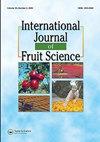在德克萨斯高平原AVA种植的葡萄嫁接到三种不同砧木上的次生芽生长和结果
IF 2.5
3区 农林科学
Q2 HORTICULTURE
引用次数: 2
摘要
近年来,葡萄和葡萄酒产业对德克萨斯州的经济影响显著增加。德克萨斯州种植的大部分葡萄都产自德克萨斯州高平原美国葡萄栽培区(AVA)。在这个AVA内的葡萄园受到晚春霜冻的影响,这可能会降低作物产量,降低水果质量。本试验的目的是比较嫁接在3个砧木(110r、1103P和Freedom)上的V. vinifera ' Grenache葡萄的初芽和次芽的生长和结果。在两个生长季节,田间种植的葡萄藤暴露于以下处理:初芽生长和强迫次生芽生长(模拟春末霜冻)。每年收集叶片气体交换、修剪蔗重、葡萄产量和果实成熟度数据。芽处理和砧木处理对叶片气体交换没有影响。以初芽和1103P为砧木的枝条重和产量数据更大。此外,从初芽和1103P砧木上生长的果实比从次生芽和其他砧木上生长的果实更成熟。结果提供了洞察“歌海娜”接穗与嫁接砧木在晚春霜冻期间在德克萨斯高平原AVA的潜在相互作用。本文章由计算机程序翻译,如有差异,请以英文原文为准。
Secondary Bud Growth and Fruitfulness of Vitis Vinifera L. ‘Grenache’ Grafted to Three Different Rootstocks and Grown within the Texas High Plains AVA
ABSTRACT In recent years, the economic impact of the grape and wine industry within Texas has significantly increased. The majority of grapes grown in Texas are produced within the Texas High Plains American Viticultural Area (AVA). Vineyards within this AVA are subject to late spring frosts that may potentially reduce crop yields, and lower fruit quality. Objectives of this experiment were to compare the growth and fruitfulness of shoots grown from primary and secondary buds of V. vinifera ‘Grenache’ vines grafted onto three rootstocks (110 R, 1103P, and Freedom). Over two growing seasons, field-grown vines were exposed to the following treatments: primary bud growth and forced secondary bud growth (simulated late spring frost). Leaf gas exchange, pruning cane weight, vine yield, and fruit maturity data were collected each year. Bud treatment or rootstock did not influence leaf gas exchange. Cane weight and yield data were greater for shoots grown from primary bud shoots, and rootstock 1103P. In addition, berries grown from primary buds and 1103P rootstocks were more mature compared to fruits from secondary buds or vines grown on other rootstocks. Results offer insight into the potential interaction of ‘Grenache’ scions with grafted rootstocks during a late spring frost within the Texas High Plains AVA.
求助全文
通过发布文献求助,成功后即可免费获取论文全文。
去求助
来源期刊

International Journal of Fruit Science
Agricultural and Biological Sciences-Agronomy and Crop Science
CiteScore
6.40
自引率
0.00%
发文量
64
审稿时长
10 weeks
期刊介绍:
The International Journal of Fruit Science disseminates results of current research that are immediately applicable to the grower, extension agent, and educator in a useful, legitimate, and scientific format. The focus of the journal is on new technologies and innovative approaches to the management and marketing of all types of fruits. It provides practical and fundamental information necessary for the superior growth and quality of fruit crops.
This journal examines fruit growing from a wide range of aspects, including:
-genetics and breeding
-pruning and training
-entomology, plant pathology, and weed science
-physiology and cultural practices
-marketing and economics
-fruit production, harvesting, and postharvest
 求助内容:
求助内容: 应助结果提醒方式:
应助结果提醒方式:


